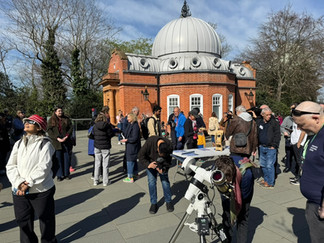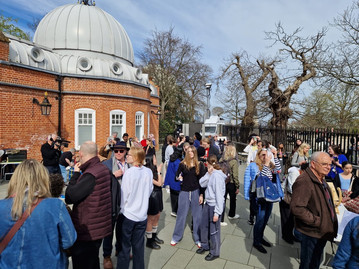Partial Solar Eclipse and Evening Skies – Observing Weekend, 29/30 March 2025
- Mike Meynell

- Mar 30
- 4 min read
What a way to kick off our 2025 solar observing season.
Saturday morning’s partial solar eclipse event at the Royal Observatory Greenwich delivered everything we could have hoped for – clear skies, big crowds, and a huge amount of public interest. The atmosphere on site was buzzing well before the first contact at 10:07am.
I arrived around 8:30am with Simon and Richard arriving shortly after, to help with setup. Greg from the ROG team had got most of the equipment ready, and a minor hiccup with a missing tripod was quickly resolved. By 9:30am, we were fully operational – including the ROG’s hydrogen-alpha telescope, a Sunspotter, and two Smartscopes (a Seestar S50 and S30), all aligned and ready for action.

From the start, it was clear this would be a busy one. Media crews from BBC, Sky, ITV, and more were on site, along with the ROG’s live stream team, whose broadcast was watched by thousands online. Several of our volunteers were interviewed and did a fantastic job representing the Flamsteed Astronomy Society and the Observatory.
The eclipse itself ran to schedule – first contact at 10:07am, maximum eclipse (with around 30% of the Sun obscured) at 11:03am, and final contact at midday. We packed up shortly afterwards, not because we ran out of interest, but because we were all slightly frazzled after hours of answering questions, speaking to the press, and managing the constant stream of curious and enthusiastic visitors.

The Sunspotter was arguably the star of the show – offering a crisp, easy-to-understand projection of the Moon’s progress across the Sun. That said, Simon’s passionate explanations at the h-alpha scope drew equally long queues, and the Smartscopes were very popular with those keen to see the eclipse on-screen. Clive had set up a fantastic imaging rig and spent most of the morning talking people through solar imaging techniques and equipment, which went down extremely well.

Our volunteer team on the day was outstanding: Eddie, David, John, Simon, Clive, Yvonne, Bobby, Mike, Tony, Ajith, Leslie, and Richard – a truly brilliant group who kept everything running smoothly and made the event a real success. Thank you all!
A Chilly but Successful Evening on Blackheath
After a packed morning at the Observatory, many of us regrouped the following evening for our final Blackheath observing session of the 2024/25 season, held on Sunday 30 March.
It was a quieter affair (as you’d expect for a Sunday night), and the cold north-westerly wind made conditions a little more uncomfortable than we’d hoped. Still, we had a strong turnout of volunteers and telescopes, and over 50 visitors came along for the evening.

Among the highlights:
A crisp 2.5% illuminated crescent Moon, low in the sky but beautifully framed.
Bright views of Jupiter, with some imaging attempts too.
A fainter but still viewable Mars.
The ever-popular Pleiades, which seemed to be the target of the night.
Images taken during the event - by Mike Meynell and Tim Rickard
One particularly nice moment saw Tim showing a visitor their first-ever view through a telescope – of their favourite object in the sky, the Pleiades. Later in the evening, he teamed up with another attendee to capture images of Jupiter, making it a proper shared observing effort.
Tony brought along his big Dobsonian scope, which gave some of the best views of the evening – especially of the Moon and Jupiter, which looked sharp even through the haze of the cold air.
I decided to mount the Seestar S30 in equatorial mode for the first time since the recent firmware update enabled this feature – and I was pleased with the results. The tracking was solid, and the object centring worked well throughout the evening.
There were plenty of questions from visitors, as always – everything from “What’s that bright one?” to more involved discussions about gear, planetary motion, and the ecliptic. Our volunteers, as ever, handled it all with patience and good humour.
That’s it for Blackheath this season – a bit of a mixed bag overall. We started and ended strongly, but the weather from November to January was against us, and we only managed 7 out of our planned 10 sessions. That said, the ones we did run were busy, successful, and full of enthusiasm from our fantastic volunteer team.
We’re now heading into our solar viewing season, with daytime observing sessions taking place at the Royal Observatory Greenwich over the spring and summer months. You can find upcoming dates and details here. Our Blackheath observing sessions will resume in September, when we’ll kick off the 2025/26 season – we look forward to seeing you there.



























































Comments